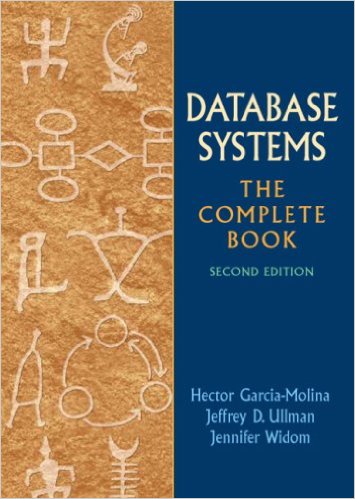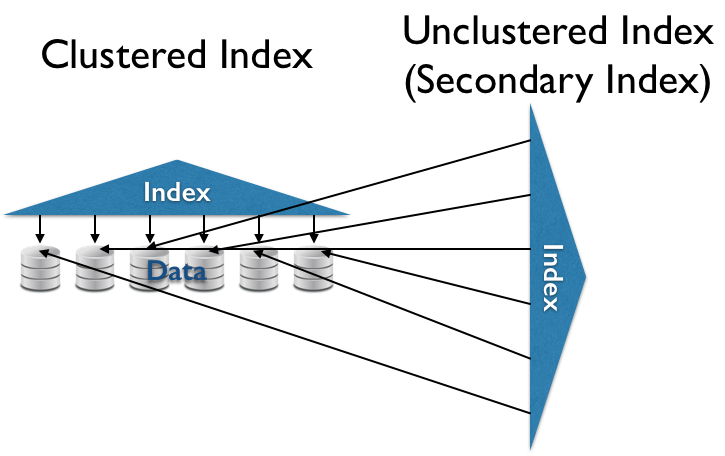Indexing
March 2, 2021
Garcia-Molina/Ullman/Widom: Ch. 8.3-8.4, 14.1-14.2, 14.4
Today
Leveraging Organization

|

|
| $150 | $50 |
| Index ToC |
No Index ToC Summary |
Today's Focus
$\sigma_C(R)$ and $(\ldots \bowtie_C R)$
(Finding records in a table really fast)
$\sigma_{R.A = 7}(R)$
Where is the data for key 7?
Option 1: Linear search
$O(N)$ IOs
Initial Assumptions
Data is sorted on an attribute of interest (R.A)
Updates are not relevant
Option 2: Binary Search
$O(\log_2 N)$ IOs
Better, but still not ideal.
Idea: Precompute several layers of the decision tree and store them together.
Fence Pointers
... but what if we need more than one page?
Add more indirection!
ISAM Trees

Which of the following is better?
Worst-Case Tree?
Best-Case Tree?
It's important that the trees be balanced
... but what if we need to update the tree?
Challenges
- Finding space for new records
- Keeping the tree balanced as new records are added
Idea 1: Reserve space for new records
Just maintaining open space won't work forever...
Rules of B+Trees
- Keep space open for insertions in inner/data nodes.
- ‘Split’ nodes when they’re full
- Avoid under-using space
- ‘Merge’ nodes when they’re under-filled
Maintain Invariant: All Nodes ≥ 50% Full
(Exception: The Root)








Deletions reverse this process (at 50% fill).
Incorporating Trees into Queries
$\sigma_C(R)$ and $(\ldots \bowtie_C R)$
Original Query: $\pi_A\left(\sigma_{B = 1 \wedge C < 3}(R)\right)$
Possible Implementations:
- $\pi_A\left(\sigma_{B = 1 \wedge C < 3}(R)\right)$
- Always works... but slow
- $\pi_A\left(\sigma_{B = 1}( IndexScan(R,\;C < 3) ) \right)$
- Requires a non-hash index on $C$
- $\pi_A\left(\sigma_{C < 3}( IndexScan(R,\;B=1) ) \right)$
- Requires a any index on $B$
- $\pi_A\left( IndexScan(R,\;B = 1, C < 3) \right)$
- Requires any index on $(B, C)$
Lexical Sort (Non-Hash Only)
Sort data on $(A, B, C, \ldots)$
First sort on $A$, $B$ is a tiebreaker for $A$,
$C$ is a tiebreaker for $B$, etc...
- All of the $A$ values are adjacent.
- Supports $\sigma_{A = a}$ or $\sigma_{A \geq b}$
- For a specific $A$, all of the $B$ values are adjacent
- Supports $\sigma_{A = a \wedge B = b}$ or $\sigma_{A = a \wedge B \geq b}$
- For a specific $(A,B)$, all of the $C$ values are adjacent
- Supports $\sigma_{A = a \wedge B = b \wedge C = c}$ or $\sigma_{A = a \wedge B = b \wedge C \geq c}$
- ...
For a query $\sigma_{c_1 \wedge \ldots \wedge c_N}(R)$
- For every $c_i \equiv (A = a)$: Do you have any index on $A$?
- For every $c_i \in \{\; (A \geq a), (A > a), (A \leq a), (A < a)\;\}$: Do you have a tree index on $A$?
- For every $c_i, c_j$, do you have an appropriate index?
- A simple table scan is also an option
Which one do we pick?
(You need to know the cost of each plan)
These are called "Access Paths"
Strategies for Implementing $(\ldots \bowtie_{c} S)$
- Sort/Merge Join
- Sort all of the data upfront, then scan over both sides.
- In-Memory Index Join (1-pass Hash; Hash Join)
- Build an in-memory index on one table, scan the other.
- Partition Join (2-pass Hash; External Hash Join)
- Partition both sides so that tuples don't join across partitions.
- Index Nested Loop Join
- Use an existing index instead of building one.
Index Nested Loop Join
To compute $R \bowtie_{S.B > R.A} S$ with an index on $S.B$- Read one row of $R$
- Get the value of $a = R.A$
- Start index scan on $S.B > a$
- Return all rows from the index scan
- Read the next row of $R$ and repeat
Index Nested Loop Join
To compute $R \bowtie_{S.B\;[\theta]\;R.A} S$ with an index on $S.B$- Read one row of $R$
- Get the value of $a = R.A$
- Start index scan on $S.B\;[\theta]\;a$
- Return all rows from the index scan
- Read the next row of $R$ and repeat
What if we need multiple sort orders?
Data Organization

Data Organization
Data Organization
- Unordered Heap
- $O(N)$ reads.
- Sorted List
- $O(\log_2 N)$ random reads for some queries.
- Clustered (Primary) Index
- $O(\ll N)$ sequential reads for some queries.
- (Secondary) Index
- $O(\ll N)$ random reads for some queries.
Hash Indexes
A hash function $h(k)$ is ...
- ... deterministic
- The same $k$ always produces the same hash value.
- ... (pseudo-)random
- Different $k$s are unlikely to have the same hash value.
$h(k)\mod N$ gives you a random number in $[0, N)$
Problems
- $N$ is too small
- Too many overflow pages (slower reads).
- $N$ is too big
- Too many normal pages (wasted space).
Idea: Resize the structure as needed
To keep things simple, let's use $$h(k) = k$$
(you wouldn't actually do this in practice)
Changing hash functions reallocates everything randomly
Need to keep the entire source and hash table in memory!
if $h(k) = x \mod N$
then
$h(k) = $ either $x$ or $2x \mod 2N$
Each key is moved (or not) to precisely one of two buckets in the resized hash table.
Never need more than 3 pages in memory at once.
Changing sizes still requires reading everything!
Idea: Only redistribute buckets that are too big
Add a directory (a level of indirection)
- $N$ hash buckets = $N$ directory entries
(but $\leq N$ actual pages) - Directory entries point to actual pages on disk.
- Multiple directory entries can point to the same page.
- When a page fills up, it (and its directory entries) split.
Dynamic Hashing
- Add a level of indirection (Directory).
- A data page $i$ can store data with $h(k)%2^n=i$ for any $n$.
- Double the size of the directory (almost free) by duplicating existing entries.
- When bucket $i$ fills up, split on the next power of 2.
- Can also merge buckets/halve the directory size.
Next time: LSM Trees and CDF-Indexing